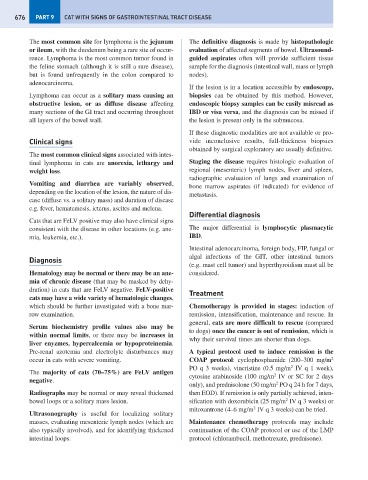Page 684 - Problem-Based Feline Medicine
P. 684
676 PART 9 CAT WITH SIGNS OF GASTROINTESTINAL TRACT DISEASE
The most common site for lymphoma is the jejunum The definitive diagnosis is made by histopathologic
or ileum, with the duodenum being a rare site of occur- evaluation of affected segments of bowel. Ultrasound-
rence. Lymphoma is the most common tumor found in guided aspirates often will provide sufficient tissue
the feline stomach (although it is still a rare disease), sample for the diagnosis (intestinal wall, mass or lymph
but is found unfrequently in the colon compared to nodes).
adenocarcinoma.
If the lesion is in a location accessible by endoscopy,
Lymphoma can occur as a solitary mass causing an biopsies can be obtained by this method. However,
obstructive lesion, or as diffuse disease affecting endoscopic biopsy samples can be easily misread as
many sections of the GI tract and occurring throughout IBD or visa versa, and the diagnosis can be missed if
all layers of the bowel wall. the lesion is present only in the submucosa.
If these diagnostic modalities are not available or pro-
Clinical signs vide inconclusive results, full-thickness biopsies
obtained by surgical exploratory are usually definitive.
The most common clinical signs associated with intes-
tinal lymphoma in cats are anorexia, lethargy and Staging the disease requires histologic evaluation of
weight loss. regional (mesenteric) lymph nodes, liver and spleen,
radiographic evaluation of lungs and examination of
Vomiting and diarrhea are variably observed,
bone marrow aspirates (if indicated) for evidence of
depending on the location of the lesion, the nature of dis-
metastasis.
ease (diffuse vs. a solitary mass) and duration of disease
e.g. fever, hematemesis, icterus, ascites and melena.
Differential diagnosis
Cats that are FeLV positive may also have clinical signs
consistent with the disease in other locations (e.g. ane- The major differential is lymphocytic plasmacytic
mia, leukemia, etc.). IBD.
Intestinal adenocarcinoma, foreign body, FIP, fungal or
algal infections of the GIT, other intestinal tumors
Diagnosis
(e.g. mast cell tumor) and hyperthyroidism must all be
Hematology may be normal or there may be an ane- considered.
mia of chronic disease (that may be masked by dehy-
dration) in cats that are FeLV negative. FeLV-positive Treatment
cats may have a wide variety of hematologic changes,
which should be further investigated with a bone mar- Chemotherapy is provided in stages: induction of
row examination. remission, intensification, maintenance and rescue. In
general, cats are more difficult to rescue (compared
Serum biochemistry profile values also may be
to dogs) once the cancer is out of remission, which is
within normal limits, or there may be increases in
why their survival times are shorter than dogs.
liver enyzmes, hypercalcemia or hypoproteinemia.
Pre-renal azotemia and electrolyte disturbances may A typical protocol used to induce remission is the
occur in cats with severe vomiting. COAP protocol: cyclophosphamide (200–300 mg/m 2
2
PO q 3 weeks), vincristine (0.5 mg/m IV q 1 week),
The majority of cats (70–75%) are FeLV antigen 2
cytosine arabinoside (100 mg/m IV or SC for 2 days
negative. 2
only), and prednisolone (50 mg/m PO q 24 h for 7 days,
Radiographs may be normal or may reveal thickened then EOD). If remission is only partially achieved, inten-
2
bowel loops or a solitary mass lesion. sification with doxorubicin (25 mg/m IV q 3 weeks) or
2
mitoxantrone (4–6 mg/m IV q 3 weeks) can be tried.
Ultrasonography is useful for localizing solitary
masses, evaluating mesenteric lymph nodes (which are Maintenance chemotherapy protocols may include
also typically involved), and for identifying thickened continuation of the COAP protocol or use of the LMP
intestinal loops. protocol (chlorambucil, methotrexate, prednisone).

